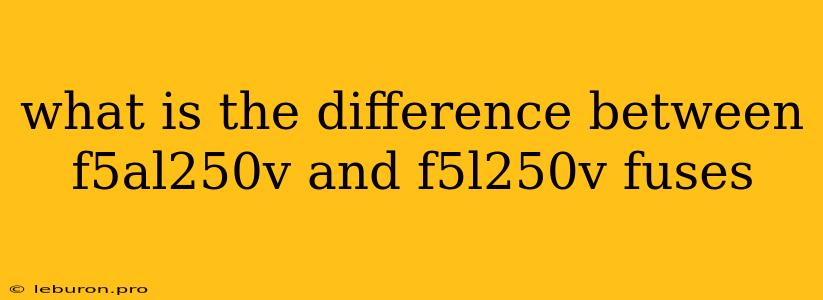When it comes to electrical safety, understanding the nuances of fuse types is crucial. Fuses are safety devices designed to protect electrical circuits from overcurrents, preventing potential damage and fire hazards. Two common fuse types are often confused: F5AL250V and F5L250V. While they share similarities, there are key differences between them that influence their application and performance. This article delves into the distinctions between these fuse types, providing a comprehensive understanding of their features and use cases.
Understanding Fuse Types: F5AL250V vs. F5L250V
F5AL250V and F5L250V are both fast-acting fuses with a nominal current rating of 5 amps (A) and a voltage rating of 250 volts (V). However, their primary difference lies in their fuse element material. The F5AL250V uses a silver-plated copper fuse element, while the F5L250V employs a tin-plated copper element. This seemingly minor distinction has significant implications for their performance characteristics.
F5AL250V: Silver-Plated Copper Fuse Element
The silver-plated copper fuse element in the F5AL250V provides several advantages:
- Faster response time: Silver has a higher conductivity than tin, allowing for faster current transmission and a quicker response to overcurrents. This translates to a faster fuse blow time, providing more immediate protection against potential hazards.
- Enhanced current carrying capacity: The higher conductivity of silver contributes to a slightly higher current carrying capacity compared to the F5L250V. This means the F5AL250V can handle slightly higher currents before blowing, potentially extending the life of the fuse in normal operating conditions.
- Improved resistance to corrosion: Silver is more resistant to corrosion than tin, making the F5AL250V more suitable for applications in humid or corrosive environments.
F5L250V: Tin-Plated Copper Fuse Element
The tin-plated copper fuse element in the F5L250V presents a different set of characteristics:
- Slower response time: Tin's lower conductivity results in a slightly slower response time compared to silver. While still fast-acting, the F5L250V may take slightly longer to blow in overcurrent situations.
- Lower current carrying capacity: Tin's lower conductivity limits the current carrying capacity of the F5L250V compared to the F5AL250V. This means the F5L250V may blow sooner in applications with higher current loads.
- Cost-effectiveness: Tin is generally less expensive than silver, making the F5L250V a more budget-friendly option.
Application Considerations for F5AL250V and F5L250V
The choice between F5AL250V and F5L250V depends on the specific requirements of the application. Here's a breakdown of their ideal use cases:
F5AL250V Applications:
- High-performance applications: The F5AL250V's faster response time makes it suitable for applications where rapid overcurrent protection is paramount, such as sensitive electronic equipment or circuits with high inrush currents.
- Circuits with higher current loads: The slightly higher current carrying capacity of the F5AL250V makes it a better choice for circuits with higher operating currents, where it can potentially withstand normal loads for a longer period.
- Humid or corrosive environments: The F5AL250V's improved corrosion resistance ensures reliable performance in environments prone to moisture or corrosive agents.
F5L250V Applications:
- Cost-sensitive applications: The F5L250V's affordability makes it ideal for applications where cost is a primary concern, such as general household appliances or simple electrical circuits.
- Circuits with lower current loads: The F5L250V is suitable for circuits with lower operating currents, where its lower current carrying capacity is not a major limitation.
- Applications with minimal corrosion concerns: The F5L250V is suitable for applications in dry and clean environments where corrosion is not a significant concern.
Conclusion: Choosing the Right Fuse
Selecting the appropriate fuse type for a specific application is essential for ensuring proper protection and circuit integrity. While both F5AL250V and F5L250V are fast-acting fuses, the difference in their fuse element material translates to distinct performance characteristics. The F5AL250V with its silver-plated copper element offers faster response time, higher current carrying capacity, and improved corrosion resistance. Conversely, the F5L250V with its tin-plated copper element presents a more cost-effective solution with a slightly slower response time and lower current carrying capacity. By carefully considering the application requirements and prioritizing factors like response time, current carrying capacity, and cost, you can choose the right fuse type for optimal performance and safety.
